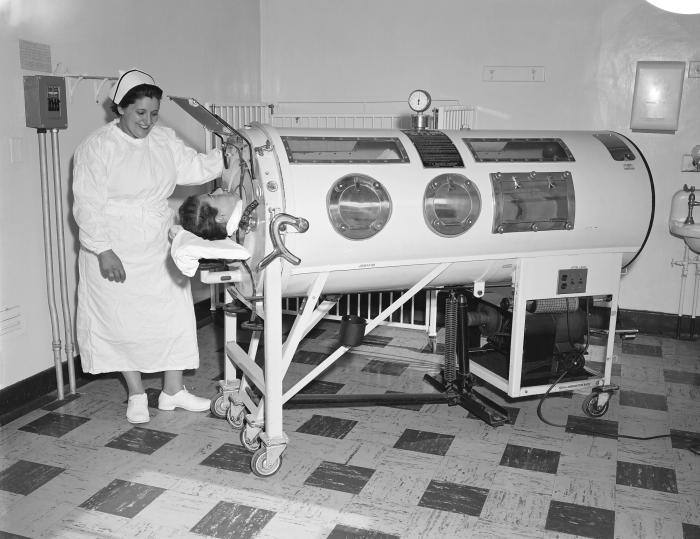Polio is one of the most dreaded childhood diseases. As late as the 1950’s, parents were terrified that polio would make their children unable to walk, or worse, unable to breathe and forced to spend the rest of their lives in an iron lung. Parents in the 1950’s refused to let their children go swimming in the summer for fear of catching polio. Of the thousands of cases every year, about 13,000-20,000 people developed paralytic polio; only 1 in 10 people would recover from the disease. President Franklin Delano Roosevelt was paralyzed by polio when he was in his 30’s. About 2%-5% of children who contracted polio died from the disease itself; many more whose respiratory muscles were paralyzed would die later from complications such as pneumonia while living in an iron lung.
The
Polio is a viral disease, which means that there is no effective antibiotic or other medication to kill the germ. The polio virus, in fact, is a member of the Enterovirus family, a group of viruses that is a common cause of disease in children and adults today. These viruses infect the gastrointestinal tract, causing diarrhea and a mild stomach flu. They can go on to spread to the nervous system and sometimes cause damage there. Perhaps the most well known enterovirus today are the ones that cause hand-foot-mouth disease in toddlers. Many other mild cases of diarrhea are also caused by enteroviruses. These viruses spread rapidly and easily, especially among children, and they tend to be summertime viruses. That is why so many children caught polio while swimming; diarrhea viruses can spread rapidly in swimming pools (and in daycares as well). Polio itself can cause diarrhea, but more commonly causes mild stomachache, sore throat, low grade fever and/or upper respiratory tract symptoms; these symptoms are indistinguishable from other common viral diseases. There is no treatment to prevent progression to paralysis.
Schedule
The IPV vaccine is given at ages 2 and 4 months. A third dose is given anywhere from 6 to 18 months; a booster is given between ages 4 and 6 years. A total of four doses are given (unless the 3rd dose is given after the child turns 4 years old; then a 4th dose is not necessary). Immunity is lifelong; however, sometimes people traveling to countries where polio is common need an additional booster.
How it is given
The vaccine is injected into the thigh or arm muscle or subcutaneous tissue (we give it in the muscle), either alone or as part of another combination vaccine (see below). It is safe and effective to give IPV along with other vaccines the same day, and it is safe and effective to give multiple injections in the same arm or leg.
Side effects
The vaccine causes virtually no side effects. Occasionally there is slight soreness and/or redness near the injection site.
Extremely rarely (1 in a million doses), an allergic reaction to any vaccine can occur causing hives and difficulty breathing, which can be treated with medications. The reaction occurs 15-30 minutes after the shot. There are no known deaths in children from an allergic reaction to a vaccine.
Risks vs. benefits
The risks of the vaccine are small, with the side effects noted above, and no one has ever died from the vaccine. While natural polio infection has been eliminated from the United States, outbreaks are still occurring in Africa, India, and Asia. Children have returned from overseas travel to the Western Hemisphere with polio, so the potential for infection still exists. For these reasons, the benefits of the vaccine outweigh the risks; to put it another way, the risks of disease outweigh the risks of the vaccine.
Contraindications & Precautions
Someone who has had a severe allergic reaction to the IPV vaccine should not get another dose. A child who is moderately or severely ill should probably delay the vaccination until he or she has recovered from the illness.
Combination vaccines
The IPV vaccine is included in the combination vaccine Pediarix™ (DTaP-HepB-IPV).
Brands/manufacturers
IPOL™ (Sanofi-Aventis), does not contain thimersol (mercury)
Related vaccines
Related information and resources
Polio (IPV) Vaccine Information Statement (from the CDC)
References
Updated Recommendations of the ACIP Regarding Routine Poliovirus Vaccination MMWR, August 7, 2009, Vol 58, #30
Poliomyelitis Prevention in the United States MMWR, May 19, 2000, Vol 49, #5
Images public domain, courtesy Public Health Image Library/CDC




